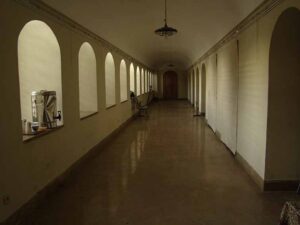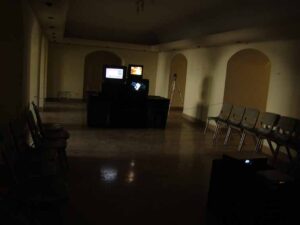
In this project, I explore how the presence of the audience and the real-time experience of an exhibition shape the artwork. While recordings can’t fully convey the emotional and interactive atmosphere of a live performance, I’ve worked hard to document some of my video art pieces.
Today, I’ll be sharing my piece titled “Distorted Time,” which was exhibited twice: first at the Isfahan Museum of Contemporary Art in Iran in 2012, and then again at the Apadana Gallery in Isfahan in 2013. The footage you’re watching right now is from the initial exhibition at the Isfahan Museum.
For this performance, I created four films. Three films were shown on old televisions and CD-ROM players, while the fourth was projected onto a screen across from them. Each television displayed a different film in a continuous loop. Originally, each film was about 200 minutes long, but after editing, they were condensed to 30 minutes to fit the exhibition’s needs.
One of the larger televisions featured segments from the eight-year Iran-Iraq War—the longest conflict of the 20th century—paired with footage of streets named after war martyrs. The medium-sized television played commercials, and the smallest one showed empty streets, devoid of people. To capture these street scenes, I filmed during two consecutive Fridays—our designated days off in Iran—starting at dawn in winter. I stood bundled up in the back of a truck to film the deserted streets, and then edited this footage into a cohesive film.
The fourth video presented a scene with a table, a sugar bowl, and individuals drinking tea. Their faces were visible only up to their mouths, while the upper parts of their faces remained out of frame.
The exhibition’s soundtrack combined electronic sounds resembling gunfire with the haunting voice of a mother mourning her son lost in the war, reciting traditional folk verses.
As visitors entered the exhibition space at the Isfahan Museum, they walked through a spacious corridor filled with tea supplies—teapots, sugar, and disposable cups. They were invited to fill a cup of tea before stepping into the video art area. In Iranian culture, offering tea is a common practice in homes and during mourning ceremonies, where mourners sit to drink tea while someone recites elegies.
The goal of this project was to remind the audience of how, over time, we can become desensitized to loss and tragedy—much like the individuals in the video, calmly drinking tea.
Video Art (Video Performance), “Distorted Time”, 2012
در این پروژه، من به بررسی تأثیر حضور تماشاگران و تجربه لحظهای نمایشگاه بر روی آثار هنری میپردازم. در حالی که فیلم نمیتوانند بهطور کامل فضای عاطفی و تعاملی یک اجرا زنده را منتقل کنند، به هر روی ویدئوپرفورمنسِ عنوان “اعوجاج زمان” در دو نوبت به نمایش درآمد: اولین بار در موزه هنرهای معاصر اصفهان در ایران در سال ۲۰۱۲ و سپس یک سال بعد در گالری آپادانا در اصفهان در سال ۲۰۱۳. فیلم و تصاویری که مشاهده میکنید، مربوط به نمایش اولیه در موزه اصفهان است. من چهار فیلم ساختم. سه فیلم بر روی تلویزیونهای قدیمی و پخشکنندههای CD-ROM نمایش داده شدند، در حالی که فیلم چهارم بر روی صفحهنمایشی در مقابل تلویزیون ها آن سوی سالن با پروجکشن (ویدئوپرژکتور) پخش شد.
هر تلویزیون فیلم متفاوتی را به صورت لوپ (LOOP= تکرار) پخش میکرد. در ابتدا، برای هر فیلم تقریباً ۲۰۰ دقیقه فیلم ضبط کرده بودم، پس از تدوین، به ۳۰ دقیقه رسید. یکی از تلویزیونها- بزرگترین شان-، بخشهایی از جنگ هشتساله ایران و عراق —طولانیترین جنگ قرن بیستم— را به نمایش گذاشت که با تصاویری از خیابانهایی که به نام شهدای جنگ نامگذاری شده بودند، ترکیب شده بود. تلویزیون متوسط، تبلیغات شبکه های داخلی را پخش میکرد و تلویزیون کوچکتر، خیابانهای خالی از آدم ها را به تصویر میکشید. برای ضبط این صحنههای خیابانی، در دو جمعه متوالی در فصل زمستان -احتمالاً بهمن ماه- از صبح موقع طلوع خورشید فیلمبرداری کردم. من در حالی که به شدت شال و کلاه کرده بودم و لباس گرم پوشیده بودم در پشت یک وانت ایستاده بودم تا خیابانهای خالی را تصویربرداری کنم. فیلم چهارم، صحنهای را نمایش میداد که در آن یک میز با یک قندان و افرادی در حال نوشیدن چای قرار داشتند. چهرههای آنها تا قسمت دهان قابل مشاهده بود، در حالی که قسمتهای بالای صورتشان خارج از کادر بود.
صدای پسزمینه نمایش شامل صداهای الکترونیکی شبیه به صدای گلولهو صدای غمگین و گرفته ی مادری بود که پسرش را در جنگ از دست داده است. او در حالی که دوبیتی هایی در غم از دست دادن فرزندش را میخواند، میگریست.
هنگامی که بازدیدکنندگان به فضای نمایشگاه در موزه هنرهای معاصر اصفهان وارد میشدند، از یک راهرو وسیع عبور میکردند که در یکی از پنجره های راهرو فلاسک چای، قند و لیوانهای یکبار مصرف قرار داشت. از بازدیدکنندگان دعوت میشد که قبل از ورود به فضای پخش ویدیو، یک لیوان چای پر کنند. در فرهنگ ایرانی، ارائه چای یک عمل رایج در خانهها و در مراسم سوگواری است، جایی که سوگواران مینشینند و چای مینوشند در حالی که کسی مرثیهخوانی میکند.
هدف از این پروژه یادآوری این نکته بود که چگونه با گذر زمان، ما میتوانیم نسبت به فقدان و تراژدیها بیحس شویم—دقیقاً مانند افرادی که در ویدیو، با آرامش چای مینوشند.

If you are interested in video art, please check out my YouTube channel.





